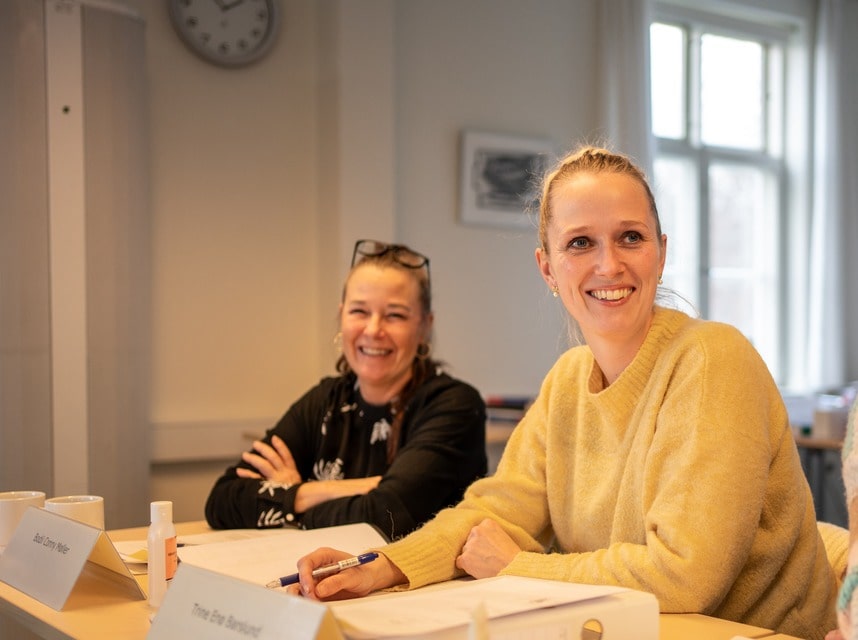Nyheder
6. maj 2024
175 forskere i verdensklasse DICE konference
Filadelfias 6. internationale konference om epilepsi, blev holdt den 2.-3. maj i Køge. Temaet var:
‘Overlappende kliniske fænotyper i monogene epilepsier – fælles molekylære veje?’ eller på engelsk ‘Overlapping clinical phenotypes in monogenic epilepsies – common molecular pathways?‘

Professor Christopher Reid, Australien.

De delte viden på kryds og tværs på den internationale konference DICE 2024. Programmet var tæt pakker med information og seneste nyt fra forskere fra over 20 forskellige lande. Christiopher Reid og Holger Lerche er fra henholdsvis Australien og Tyskland. De mødte hinanden første gang i 2007, og er nu kollegaer inden for forskningen af genetik og epilepsi.
Se programmet her:
16.30-19.00 Preconference meeting
19.00-21.00 Welcome reception
Session 1
8.45-9.00
Introduction to conference
Session 1 Overlapping clinical phenotypes – common molecular pathways?
9:00 – 9.25
Andreas Brunklaus (Glasgow, UK) The extended spectrum of SCN1A-related disorders: how does function relate to the clinic?
9.25-9.50
Elena Gardella (Dianalund, DK) Sodium channelopathies: clinical commonalities and differences
9.50-10.15
Sebastian Ortiz (Dianalund, DK) Distrinct clinical phenotypes associated with LOF vs GOF GABAA-receptor variants
10.15-10.45 Coffee break
Session 1 – Continued
10.45-11.10
Carla Marini (Ancona, IT) PRRT2 variants in self-limiting epilepsy, paroxysmal dyskinesia, and hemiplegic migraine
11.10-11.35
Steffen Syrbe (Heidelberg, GER) The spectrum of CACNA1A-related disorders
11.35-12.00
Robert Lauerer-Braun (Tübingen, GER) CACNA1E variants in Developmental and
Epileptic Encephalopathy with contractures, macrocephaly and dyskinesia
12.00-12.25
Johannes Lemke (Leipzig, GER) GRIN-related disorders: diversification of inheritance pattern, phenotypic spectrum, and treatment approaches
12.25-13.30 Lunch
Session 1 – Continued
13.30-14.15
Kevin Bender (San Francisco, USA) & Stephan Sanders (Oxford, UK) Similar clinical phenotypes – shared genetic mechanisms?
14.15-14.35
Panel discussion
14.35-15.00 Coffee break
Session 2 – Clinical relevance of EEG biomarkers in monogenic epilepsies
15.00-15.25
Roberta Cilio (Brussels, BE) EEG biomarkers in neonatal onset epilepsies
15.25-15.50
Guido Rubboli (Dianalund, DK) EEG phenotyping: Still a valuable tool for genotype-phenotype correlations?
15.50-16.15
Alberto Cossu (Verona, IT) Quantitative EEG biomarkers for STXBP1-related disorders
16:15-16.40
Stéphane Auvin (Paris, FR) The usefulness of EEG biomarkers in clinical trials
16.40-17.00
Panel discussion
17.00-18.00 Coffee break & Poster Session
Session 3: Late Breaking News
18.00-19.00
Late breaking news
18.00-19.00
Lorenz Kiwull (Salzburg, AUT): Overlapping molecular pathways – common clinical penotypes? Standard procedure for common data elements in groups of rare diseases using the example of SYNGAP1 and classical RASopathies
18.15-18.30
Philip K. Ahring (Sydney, AUS): Can paralogous epilepsy-associated GABAA receptor variants be used as indicators for clinical outcomes?
18.30-18.45
Christopher Reid (Melbourne, AUS): Enhanced inhibition in hippocampal pyramidal neurons in a gain-of-function GABRB3 mouse model of epilepsy
18.45-19.00
Jean-Francois Perrier (Copenhagen, DK): Understanding and treating STXBP1 neurodevelopmental encephalopathy
19.45 Conference dinner
Session 4: Precision Medicine in Genetic Epilepsies: Concepts and Research Strategies
8.30-8.55
Rikke Møller, (Dianalund, DK), Precision medicine in genetic epilepsies
8.55-9.20
Maurizio Taglialatela (Naples, IT) How can drug repurposing inform us of dysfunctional mechanisms? Yelds and challenges
9.20-9.45
Snezana Majevic (Melbourne, AUS) Leveragine iPSC-derived disease models to propel precision medicine treatments for Developmental and Epileptic Encephalopathy
9.45-10.10
Massimo Montegazza (Nice, FR) The role of mouse models of genetic epilepsies in precision medicine
10.10-10.20
Rami Aqeilan (Jerusalem, ISR) Modelling and Characterizing WOREE Syndrome: from Basic Science to Translational Medicine
10.20-10.45
Panel discussion
10.45-11.10 Coffee break
Session 5: Molecular therapeutic Board
11.00-13.00
Case presentations of precision medicine in genetic epilepsies
11.10-11.25
Matthias De Wachter (Antwerp/Dianalund, BEL/DK): KCNA2-GOF and GOF-LOF Developmental and Epileptic Encephalopathy: an update on treatment response of 4-Aminopyridine
11.25-11.40
Illona Krey (Leipzig/Atlanta, GER/USA): Precision medicine approaches in GRIN-related disorders – what do we know and what’s next?
11.40-11.55
Pierandrea Muglia (Brussels, BEL): Radiprodil, a NR2-NMDA negative allosteric modulator in clinical development for GRIN related disorders
11.55-12.10
Cathrine Gjerulfsen (Dianalund, DK): Cenobamate as add-on treatment in SCN8A related developmental and epileptic encephalopathy
12.10-12.25
Laia Nou Fontanet (Barcelona, SP): AFG2A-related Encephalopathy: Clinical phenotype and ketogenic diet effect (in vivo and in vitro effect)
12.25-12.40
Vivian Liao (Sydney, AUS): Vinpocetine improves epilepsy and comorbidity outcomes in patients with GABAA receptor loss-of-function variants
12.40-12.50
Steve Petrou (Boston, USA): Revolutionizing Treatment for Early-Onset Developmental and Epileptic Encephalopathy: A first look at ASO Therapy for SCN2A
12.50-13.00
Evelina Carapancea (Brussels, BEL): Everolimus precision therapy in a patient withe NPEL3-related epilepsy
13.00-13.10
Ida Cursio (Ancona, IT) Generalized epilepsy, intellectual disability, behavioral disorder and familiar tremor due to compund heterozigosity of the CAD gene
13.10-13.45
Matthew C. Walker (London, UK) Therapies of the future
13.45-14.00
Concluding remarks








